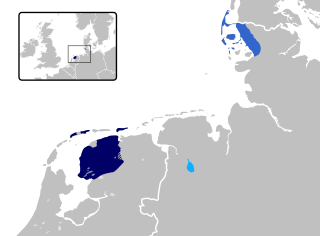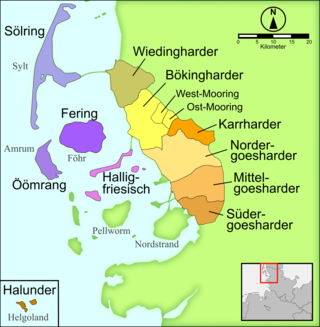
The Frisian languages are a closely related group of West Germanic languages, spoken by about 500,000 Frisian people, who live on the southern fringes of the North Sea in the Netherlands and Germany. The Frisian languages are the closest living language group to the Anglic languages; the two groups make up the Anglo-Frisian languages group and together with the Low German dialects these form the North Sea Germanic languages. However, modern English and Frisian are not mutually intelligible, nor are Frisian languages intelligible among themselves, owing to independent linguistic innovations and foreign influences.
The Frisians are a Germanic ethnic group native to the coastal regions of the Netherlands and northwestern Germany. They inhabit an area known as Frisia and are concentrated in the Dutch provinces of Friesland and Groningen and, in Germany, East Frisia and North Frisia. The name is probably derived from frisselje. The Frisian languages are spoken by more than 500,000 people; West Frisian is officially recognised in the Netherlands, and North Frisian and Saterland Frisian are recognised as regional languages in Germany.

Low Saxon, also known as West Low German is a group of Low German dialects spoken in parts of the Netherlands, northwestern Germany and southern Denmark. It is one of two groups of mutually intelligible dialects, the other being East Low German dialects. A 2005 study found that there were approximately 1.8 million "daily speakers" of Low Saxon in the Netherlands. 53% spoke Low Saxon or Low Saxon and Dutch at home and 71% could speak it. According to another study the percentage of speakers among parents dropped from 34% in 1995 to 15% in 2011. The percentage of speakers among their children dropped from 8% to 2% in the same period.

Frisia is a cross-border cultural region in Northwestern Europe. Stretching along the Wadden Sea, it encompasses the north of the Netherlands and parts of northwestern Germany. The region is traditionally inhabited by the Frisians, a West Germanic ethnic group.
Northern Low Saxon is a subgroup of Low Saxon dialects of Low German. As such, it covers a great part of the West Low German-speaking areas of northern Germany, with the exception of the border regions where Eastphalian and Westphalian are spoken, and Gronings dialect in the Netherlands.

Anglia is a small peninsula on the eastern coast of Jutland. Jutland consists of the mainland of Denmark and the northernmost German state of Schleswig-Holstein. Anglia belongs to the region of Southern Schleswig, which constitutes the northern part of Schleswig-Holstein, and protrudes into the Bay of Kiel of the Baltic Sea.

Low German or Low Saxon is a West Germanic language variety spoken mainly in Northern Germany and the northeastern part of the Netherlands. The dialect of Plautdietsch is also spoken in the Russian Mennonite diaspora worldwide.

West Frisian, or simply Frisian, is a West Germanic language spoken mostly in the province of Friesland in the north of the Netherlands, mostly by those of Frisian ancestry. It is the most widely spoken of the Frisian languages.

North Frisian (nordfriisk) is a minority language of Germany, spoken by about 10,000 people in North Frisia. The language is part of the larger group of the West Germanic Frisian languages. The language comprises 10 dialects which are themselves divided into an insular and a mainland group.

Achtrup is a municipality in Nordfriesland district, in Schleswig-Holstein in northern Germany.
South Jutlandic or South Jutish is a dialect of the Danish language. South Jutlandic is spoken in Southern Jutland on both sides of the border between Denmark and Germany.

Süderlügum is a municipality in the district of Nordfriesland, in Schleswig-Holstein, Germany. It is situated near the border with Denmark, approximately 35 km west of Flensburg, and 7 km southeast of Tønder.

Sylt Frisian, or Söl'ring, is the dialect of the North Frisian language spoken on the island of Sylt in the German region of North Frisia. Söl'ring refers to the Söl'ring Frisian word for Sylt, Söl'. Together with the Fering, Öömrang, and Heligolandic dialects, it forms part of the insular group of North Frisian dialects. It differs from the mainland dialects because of its relatively strong Danish influence. Due to mass tourism on Sylt, the dialect has been largely displaced by forms of German and Söl'ring is spoken only by a few hundred people, many of whom no longer reside on Sylt. Although it is taught in several primary schools, its prospects for survival are unfavorable compared with other insular dialects. An online dictionary is available for looking up German to Söl'ring translations and vice versa.

Amrum Frisian, or Öömrang, is the dialect of the North Frisian language spoken on the island of Amrum in the German region of North Frisia. Öömrang refers to the Öömrang Frisian name of Amrum, Oomram. Together with the Fering, Söl'ring, and Heligolandic dialects, it forms part of the insular group of North Frisian dialects, and it is very similar to Fering. Öömrang is spoken by about one third of Amrum's 2300 people.

Halligen Frisian is the dialect of the North Frisian language spoken on the Halligen islands, primarily Langeneß and Hooge, in the German region of North Frisia. The dialect has survived despite the islands' being home to less than 300 people and unprotected by dikes, mandating evacuations during storms. However, it is now in danger of extinction. Although it is spoken on islands, it is considered part of the Mainland North Frisian dialects as opposed to the Insular North Frisian Dialects, due to its linguistic features.
Dutch dialects are primarily the dialects that are both cognate with the Dutch language and are spoken in the same language area as the Dutch standard language. Dutch dialects are remarkably diverse and are found in the Netherlands and northern Belgium.
Strand Frisian was a dialect of the North Frisian language which was originally spoken on Strand island, Duchy of Schleswig. Strand was destroyed in the Burchardi flood of 1634 with its remnants forming the islands Pellworm and Nordstrand which are now part of Germany. Strand Frisian is counted among the mainland group of North Frisian dialects.

Eiderstedt Frisian was a dialect of the North Frisian language which was originally spoken on Eiderstedt, formerly part of the Danish Duchy of Schleswig. The Frisian language became extinct on Eiderstedt in mid-18th-Century.
Southern Schleswig Danish is a variety of the Danish language spoken in Southern Schleswig in Northern Germany. It is a variety of Standard Danish influenced by the surrounding German language in relation to prosody, syntax and morphology, used by the Danish minority in Southern Schleswig.











